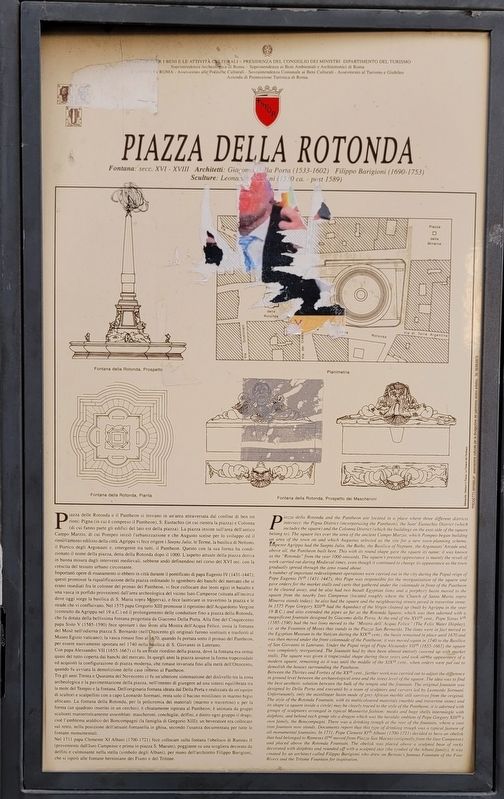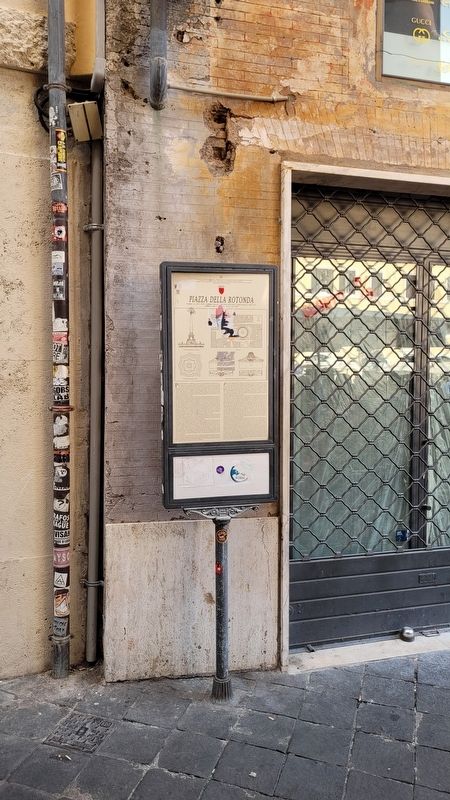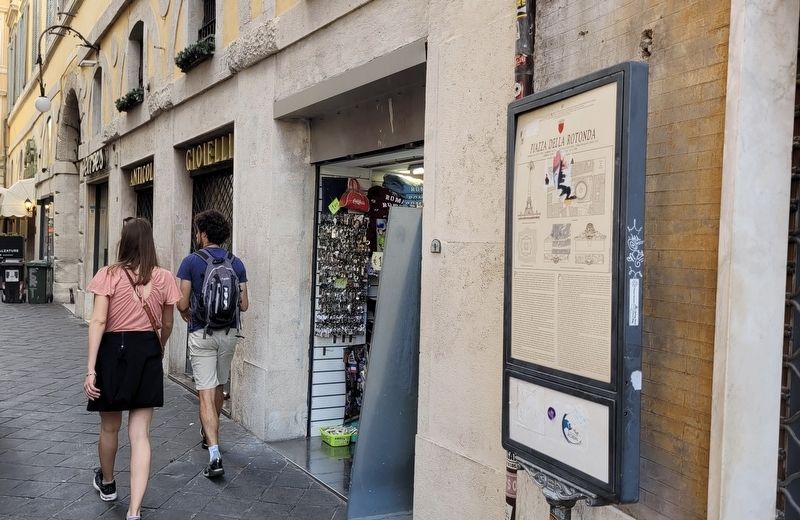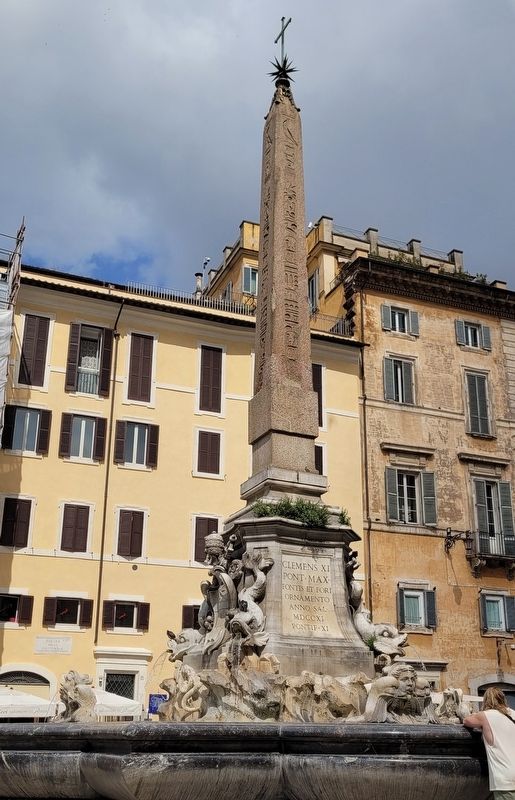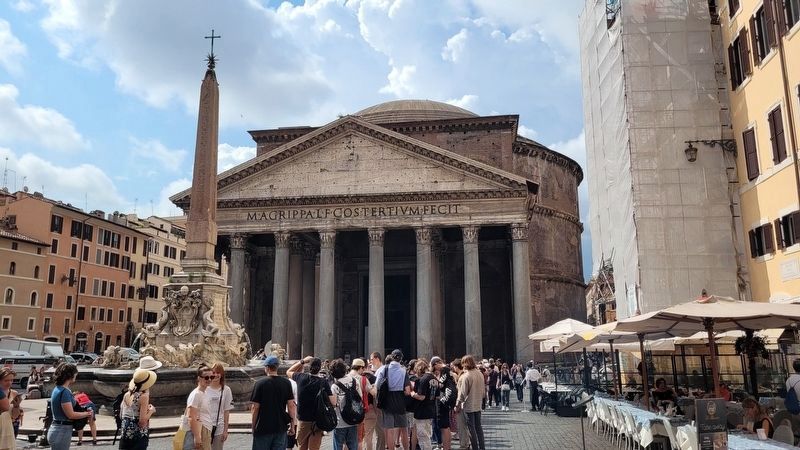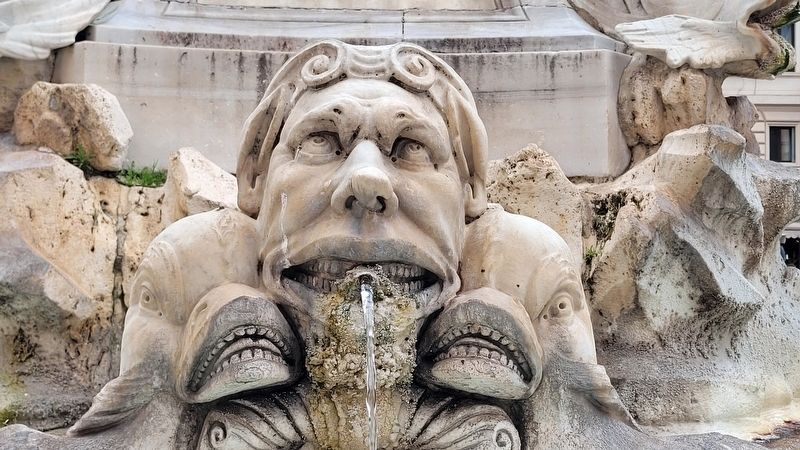Colonna in Roma in Città metropolitana di Roma Capitale, Latium, Rome, Italy — Central Italy (Tyrrhenian Coast)
Piazza della Rotonda
Architetti: Giacoma Della Porta (1533-1602) Filippo Barigioni (1690-1753)
Sculture: Leonardo Sormani (1503 ca.-post 1589)
Piazza delle Rotonda e il Pantheon si trovano in un'area attraversata dal confine di ben tre rioni: Pigna (in cui è compreso il Pantheon), S. Eustachio (in cui rientra la piazza) e Colonna (di cui fanno parte gli edifici del lato est della piazza). La piazza insiste sull'area dell'antico Campo Marzio, di cui Pompeo iniziò l'urbanizzazione e che Augusto scelse per lo sviluppo ed il rinnovamento edilizio della città. Agrippa vi fece erigere i Saepta Julia, le Terme, la basilica di Nettuno, il Portico degli Argonauti e, emergente tra tutti, il Pantheon. Questo con la sua forma ha condi- zionato il nome della piazza, detta della Rotonda dopo il 1000. L'aspetto attuale della piazza deriva in buona misura dagli interventi medievali, sebbene andò definendosi nel corso del XVI sec. con la crescita del tessuto urbano circostante.
Importanti opere di risanamento si ebbero in città durante il pontificato di papa Eugenio IV (1431-1447); questi promosse la riqualificazione della piazza ordinando lo sgombero dei banchi del mercato che si erano insediati fra le colonne del pronao del Pantheon, vi fece collocare due leoni egizi in basalto e una vasca in porfido provenienti dall'area archeologica del vicino Iseo Campense (situata all'incirca dove oggi sorge la basilica di S. Maria sopra Minerva), e fece lastricare in travertino la piazza e le strade che vi confluivano. Nel 1575 papa Gregorio XIII promosse il ripristino dell'Acquedotto Vergine (costruito da Agrippa nel 19 a.C.) ed il prolungamento delle condutture fino a piazza della Rotonda, che fu dotata della bellissima fontana progettata da Giacomo Della Porta. Alla fine del Cinquecento papa Sisto V (1585-1590) fece spostare i due leoni alla Mostra dell'Acqua Felice, ossia la fontana del Mosè nell'odierna piazza S. Bernardo (nell'Ottocento gli originali furono sostituiti e trasferiti al Museo Egizio vaticano); la vasca rimase fino al 1670, quando fu portata sotto il pronao del Pantheon, per essere nuovamente spostata nel 1740 nella basilica di S. Giovanni in Laterano.
Con papa Alessandro VII (1655-1667) ci fu un reale riordino della piazza, dove la fontana era ormai quasi del tutto coperta dai banchi del mercato. In quegli anni la piazza assunse la forma trapezoidale ed acquistò la configurazione di piazza moderna, che rimase invariata fino alla metà dell'Ottocento, quando fu avviata la demolizione delle case intorno al Pantheon.
Tra gli anni Trenta e Quaranta del Novecento ci fu un'ulteriore sistemazione del dislivello tra la zona archeologica e la pavimentazione della piazza, nell'intento di giungere ad una sintesi equilibrata tra la mole del Tempio e la fontana. Dell'originaria fontana ideata dal Della Porta e realizzata da un'equipe di scultori e scalpellini con a capo Leonardo Sormani, resta solo il bacino mistilineo in marmo bigio africano. La fontana della Rotonda, per la policromia dei materiali (marmo e travertino) e per la forma (un quadrato inserito in un cerchio), è chiaramente ispirata al Pantheon; è animata da gruppi scultorei manieristicamente assemblati: mascheroni, conchiglie, delfini, e dietro ogni gruppo il drago, cioè l'emblema araldico dei Boncompagni (la famiglia di Gregorio XIII); un beveratore era collocato sul retro, nella posizione dell'attuale fontanella in ghisa, secondo l'usanza documentata per tutte le fontane monumentali.
Nel 1711 papa Clemente XI Albani (1700-1721) fece collocare sulla fontana l'obelisco di Ramses II (proveniente dall'Iseo Campense e prima in piazza S. Macuto), poggiante su una scogliera decorata da delfini e culminante nella stella (simbolo degli Albani), per mano dell'architetto Filippo Barigioni, che si ispirò alle fontane berniniane dei Fiumi e del Tritone.
Didascalie
Fontana della Rotonda, Prospetto
Fontana della Rotonda, Pianta
Planimetria
Fontana della Rotonda, Prospetto dei Mascheroni
Architects: Giacoma Della Porta (1533-1602) Filippo Barigioni (1690-1753)
Sculptures: Leonardo Sormani (1503 ca.-post 1589)
Piazza della Rotonda and the Pantheon are located in a place where three different districts intersect: the Pigna District (incorporating the Pantheon), the Sant' Eustachio District (which includes the square) and the Colonna District (which the buildings on the east side of the square belong to). The square lies over the area of the ancient Campo Marzio, which Pompeo began building an area of the town on and which Augustus selected as the site for a new town-planning scheme. Emperor Agrippa had the Saepta Julia, the Baths, the Basilica of Neptune, the Argonauts' Arcade and above all, the Pantheon built here. This with its round shape gave the square its name: it was known as the "Rotonda" from the year 1000 onwards. The square's present appearance is mainly the result of work carried out during Medieval times, even though it continued to change its appearance as the town gradually spread through the area round about.
A number of important redevelopment operations were carried out in the city during the Papal reign of Pope Eugenio IVth (1431-1447); this Pope was responsible for the reorganisation of the square and gave orders for the market stalls and carts that gathered under the colonnade in front of the Pantheon to be cleared away, and he also had two basalt Egyptian lions and a porphyry basin moved to the square from the nearby Iseo Campense (located roughly where the Church of Santa Maria sopra Minerva stands today); he also had the square and the neighbouring streets paved in travertine stone. In 1575 Pope Gregory XIIIth had the Aqueduct of the Virgin cleaned up (built by Agrippa in the year 19 B.C.) and also extended the pipes as far as the Rotonda Square, which was then adorned with a magnificent fountain designed by Giacomo della Porta. At the end of the XVIth cent., Pope Sixtus Vth (1585-1590) had the two lions moved to the "Mostra dell' Acqua Felice" (The Felix Water Display), i.e. at the Fountain of Moses that stands in the Piazza San Bernardo. The lions were in fact moved to the Egyptian Museum in the Vatican during the XIXth cent.; the basin remained in place until 1670 and was then moved under the front colonnade of the Pantheon; it was moved again in 1740 to the Basilica of San Giovanni in Laterano. Under the Papal reign of Pope Alexander VIIth (1655-1667) the square was completely reorganised. The fountain had by then been almost
entirely covered up with market stalls. The square was given it trapezoidal shape during these years and took on the appearance of a modern square, remaining as it was until the middle of the XIXth cent., when orders were put out to demolish the houses surrounding the Pantheon.
Between the Thirties and Forties of the XXth cent., further work was carried out to adjust the difference in ground level between the archaeological area and the street level of the square. The idea was to find the best aesthetic solution between the bulk of the temple and the fountain. The original fountain was designed by Della Porta and executed by a team of sculptors and carvers led by Leonardo Sormani. Unfortunately, only the mixtilinear basin made of grey African marble still survives from the original. The style of the Rotonda Fountain, with its multicoloured materials (marble and travertine stone) and its shape (a square inside a circle) may be clearly traced to the style of the Pantheon; it is adorned with groups of sculptures arranged in typical Mannerist fashion: masks and huge shells intermingle with dolphins, and behind each group sits a dragon which was the heraldic emblem of Pope Gregory XIIIth's own family, the Boncompagni. There was a drinking trough at the rear of the fountain, where a cast iron fountain now stands. Documents report that this type of drinking trough was a typical feature of all monumental fountains. In 1711, Pope Clement XIth Albani (1700-1721) decided to have an obelisk that had belonged to Rameses IInd moved from Piazza San Macuto (originally from the Iseo Campense) and placed above the Rotonda Fountain. The obelisk was placed above a sculpted base of rocks decorated with dolphins and rounded off with a sculpted star (the symbol of the Albani family). It was created by an architect called Filippo Barigioni who drew on Bernini's famous Fountain of the Four Rivers and the Tritone Fountain for inspiration.
Captions
Rotonda Fountain, Prospectus
Rotonda Fountain, Plan
Floor plan
Rotonda Fountain, Prospectus of the Masks
Erected by Ministero per i Beni e le Attività Culturali, Presidenza del Consiglio dei Ministri, Dipartimento del Turismo, Comune di Roma, Assessorato alle Politiche Culturale, Sovraintendenza Comunale ai Beni Culturali, Soprintendenza Archeological di Roma, Soprintendenza ai Beni Ambientali e Architettonici di Roma and Azienda di Promozione Turistica di Roma.
Topics. This historical marker is listed in these topic lists: Architecture • Industry & Commerce.
Location. 41° 53.977′ N, 12° 28.615′ E. Marker is in Roma, Lazio (Latium, Rome), in Città metropolitana di Roma Capitale. It is in Colonna. Marker is at the intersection of Via del Pantheon and Piazza della Rotonda, on the right when traveling north on Via del Pantheon. The marker is located along the east side of the street. Touch for map. Marker is at or near this postal address: Via del Pantheon 60, Roma, Lazio 00186, Italy. Touch for directions.
Other nearby markers. At least 8 other markers are within walking distance of this marker. Hotel del Sole (here, next to this marker); Rione III Colonna / Colonna District III (within shouting distance of this marker); The Trevi-Pantheon Route (within shouting distance of this marker); Hotel Pantheon (within shouting distance of this marker); Pantheon (within shouting distance of this marker); L'eclisse / The Eclipse (about 90 meters away, measured in a direct line); a different marker also named Trevi-Pantheon Route (about 120 meters away); Chiesa di San Luigi dei Francesi / Church of St. Louis of the French (about 180 meters away). Touch for a list and map of all markers in Roma.
Also see . . . Piazza della Rotonda. Wikipedia
The Piazza della Rotonda is a piazza (city square) in Rome, Italy, on the south side of which is located the Pantheon. The square gets its name from the Pantheon's informal title as the church of Santa Maria Rotonda.(Submitted on July 27, 2023, by James Hulse of Medina, Texas.)
Credits. This page was last revised on July 27, 2023. It was originally submitted on July 25, 2023, by James Hulse of Medina, Texas. This page has been viewed 47 times since then and 8 times this year. Photos: 1, 2, 3, 4, 5, 6. submitted on July 27, 2023, by James Hulse of Medina, Texas.
